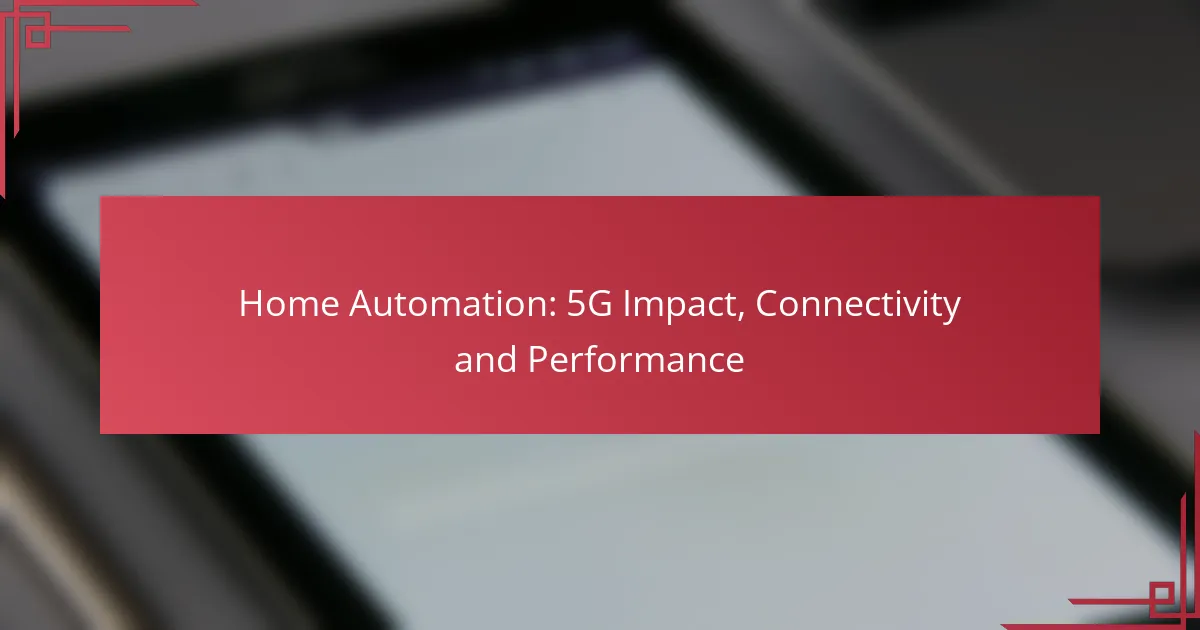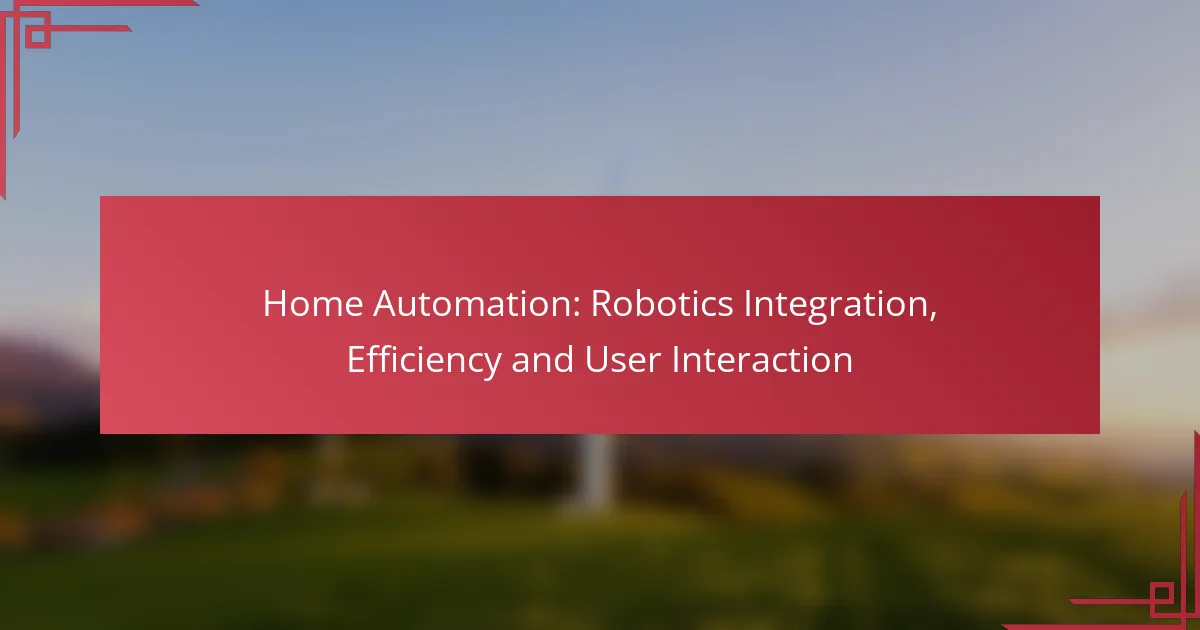The advent of 5G technology is revolutionizing home automation by delivering faster connectivity and lower latency, which are crucial for the seamless integration of smart devices. With the ability to support a greater number of devices, 5G enhances the performance and user experience of home automation systems, making them more efficient and responsive. Leading platforms like Google Nest, Amazon Echo, and Apple HomeKit are leveraging these advancements to optimize device communication and functionality.

How does 5G enhance home automation in Ireland?
5G significantly enhances home automation in Ireland by providing faster connectivity, lower latency, and the ability to support more devices. This technology allows for seamless integration of smart home devices, improving their performance and user experience.
Increased connectivity speed
5G technology offers connectivity speeds that can reach up to 10 Gbps, which is substantially faster than previous generations. This increase in speed enables quick data transfers between devices, allowing for instant responses from smart home systems.
For example, streaming high-definition video from security cameras or controlling multiple devices simultaneously becomes much smoother. Users can expect less buffering and interruptions, enhancing overall functionality.
Lower latency for real-time control
With 5G, latency can drop to as low as 1 millisecond, which is crucial for real-time control of smart devices. This means that commands sent to devices, such as lights or thermostats, are executed almost instantly.
Lower latency is particularly important for applications like home security systems, where immediate responses can prevent potential threats. Users can remotely monitor and control their homes without noticeable delays.
Support for more connected devices
5G networks can support up to one million devices per square kilometer, vastly increasing the number of smart devices that can be connected in a home. This capability allows homeowners to integrate various devices without worrying about network congestion.
As a result, users can have multiple smart appliances, security systems, and sensors operating simultaneously, all communicating efficiently. This scalability is essential for future-proofing home automation setups.
Improved energy efficiency
5G technology can enhance energy efficiency in home automation by optimizing how devices communicate. Smart devices can enter low-power modes when not in use, conserving energy while remaining connected.
For instance, smart thermostats can adjust their settings based on real-time data, reducing energy consumption without sacrificing comfort. This not only lowers utility bills but also contributes to a more sustainable home environment.
Enhanced security features
5G networks provide improved security features, including advanced encryption and more robust authentication methods. This is vital for protecting sensitive data transmitted between smart devices and users.
Additionally, the increased speed and capacity of 5G allow for better monitoring and response capabilities, such as real-time alerts for unusual activity detected by security cameras. Homeowners can feel more secure knowing their systems are protected by the latest technology.
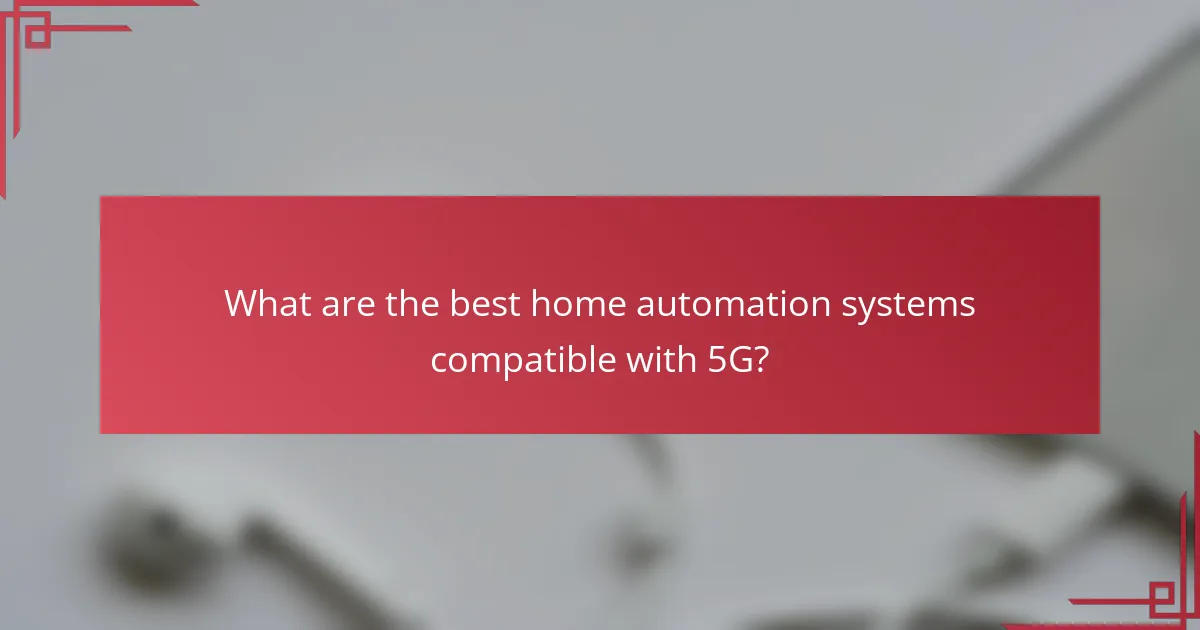
What are the best home automation systems compatible with 5G?
The best home automation systems compatible with 5G include Google Nest, Amazon Echo, Samsung SmartThings, and Apple HomeKit. These platforms leverage 5G’s high-speed connectivity to enhance device communication, reduce latency, and improve overall performance.
Google Nest
Google Nest offers a range of smart devices that work seamlessly with 5G networks. The integration allows for faster response times and improved connectivity for devices like smart speakers, cameras, and thermostats.
When using Google Nest, consider the compatibility of your existing devices. Most Nest products support Wi-Fi, but 5G can enhance their capabilities, especially in larger homes where Wi-Fi signals may weaken.
Amazon Echo
Amazon Echo devices are designed to take full advantage of 5G technology, enabling quicker interactions with Alexa and other smart home devices. This results in a more responsive home automation experience.
To maximize performance, ensure your Echo devices are updated regularly. Additionally, consider using Echo devices in different rooms to create a mesh network that benefits from 5G’s speed and reliability.
Samsung SmartThings
Samsung SmartThings is a versatile platform that supports a wide array of smart devices and integrates well with 5G. This compatibility allows for real-time monitoring and control of your home automation system.
When setting up SmartThings, focus on the devices that are 5G-enabled to fully utilize the network’s capabilities. It’s also beneficial to group devices by function, such as lighting or security, for easier management.
Apple HomeKit
Apple HomeKit provides a secure and user-friendly environment for managing smart home devices, and it works effectively with 5G networks. The enhanced speed allows for smoother operation of connected devices like lights, locks, and cameras.
For optimal performance, ensure your HomeKit devices are compatible with 5G and are updated to the latest software. This will help maintain security and improve the overall functionality of your home automation system.
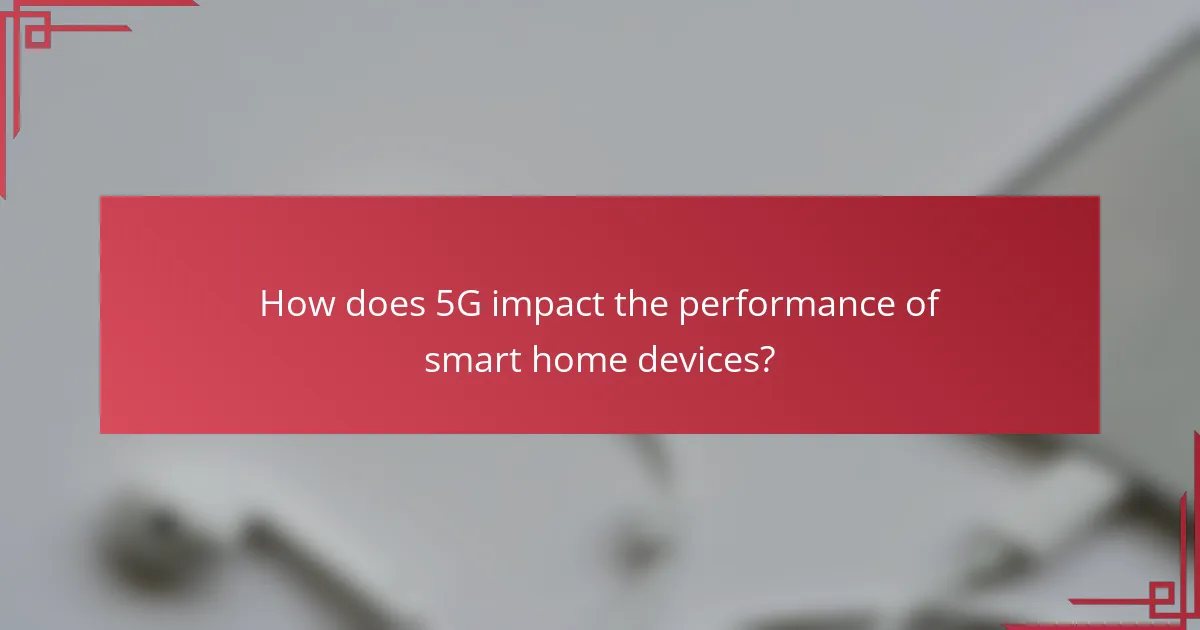
How does 5G impact the performance of smart home devices?
5G significantly enhances the performance of smart home devices by providing faster data speeds, lower latency, and improved connectivity. This results in more efficient operation of devices, enabling them to respond quickly and reliably to user commands and automated settings.
Faster response times
With 5G technology, smart home devices can achieve response times in the low tens of milliseconds, compared to the higher latency often experienced with older networks. This rapid communication allows for immediate actions, such as turning on lights or adjusting thermostats, creating a seamless user experience.
For instance, when using voice commands to control devices, the near-instantaneous response of 5G can make interactions feel more natural and efficient. Users can expect a significant reduction in delays, enhancing the overall functionality of their smart homes.
Better streaming quality for security cameras
5G enables higher bandwidth, which translates to better streaming quality for security cameras. Users can enjoy high-definition video feeds without buffering, even when multiple cameras are streaming simultaneously.
This improved quality is crucial for monitoring homes effectively, as it allows for clearer images and more reliable video recordings. Homeowners can access live feeds from their devices without interruptions, ensuring they stay informed about their property’s security.
More reliable device communication
5G enhances the reliability of communication between smart home devices, reducing the chances of disconnections or lag. This is particularly important in homes with numerous connected devices, where older networks may struggle to maintain stable connections.
For example, in a smart home setup with multiple sensors, lights, and appliances, 5G ensures that all devices can communicate effectively without interference. This reliability is essential for automated systems to function correctly, providing peace of mind for homeowners.
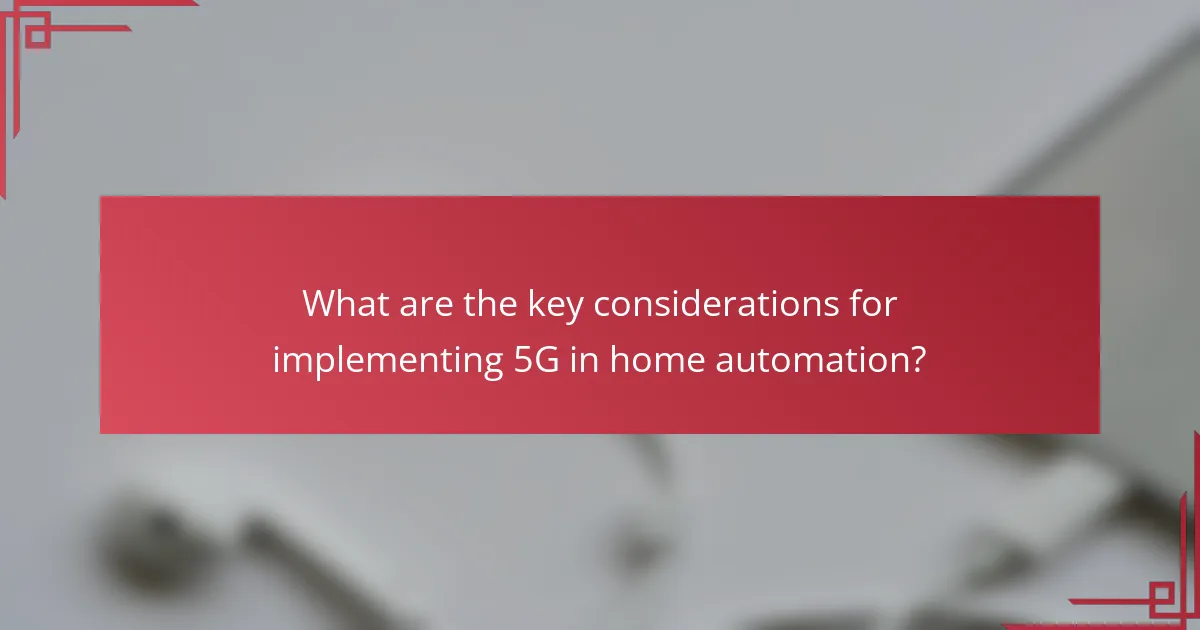
What are the key considerations for implementing 5G in home automation?
Implementing 5G in home automation requires careful consideration of device compatibility, network coverage, and the costs associated with upgrading existing systems. These factors can significantly influence the effectiveness and efficiency of smart home technologies.
Device compatibility
Ensuring device compatibility is crucial when integrating 5G into home automation systems. Many existing smart devices may not support the new 5G standards, necessitating upgrades or replacements. Check for devices that explicitly state 5G compatibility to avoid connectivity issues.
Consider investing in devices from reputable manufacturers that are known for timely updates and support. This can help ensure your home automation system remains functional and efficient as technology evolves.
Network coverage in urban areas
5G network coverage varies significantly across urban areas, impacting the performance of home automation systems. Before implementing 5G, verify the availability of a robust 5G network in your location. In many cities, coverage can be spotty, which may lead to inconsistent device performance.
Utilizing coverage maps provided by network carriers can help identify areas with strong 5G signals. If coverage is limited, consider alternative solutions like Wi-Fi 6 or mesh networks to maintain reliable connectivity for your smart devices.
Cost of upgrading systems
The cost of upgrading to 5G-compatible systems can vary widely based on the number of devices and the complexity of your home automation setup. Budgeting for new devices, potential installation fees, and service plans is essential. Expect to spend anywhere from a few hundred to several thousand dollars, depending on your needs.
To minimize costs, prioritize upgrading the most critical devices first, such as security systems or smart hubs. Look for bundled offers from manufacturers or service providers that can provide savings on multiple devices or services.
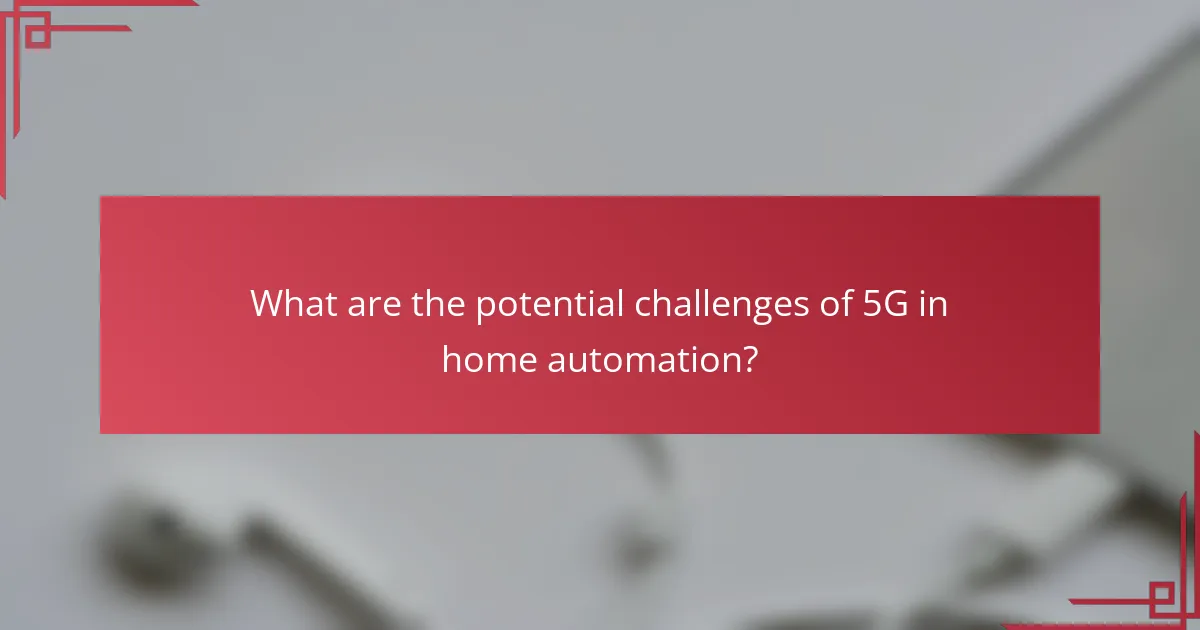
What are the potential challenges of 5G in home automation?
The potential challenges of 5G in home automation include infrastructure limitations, security concerns, and compatibility issues with existing devices. Addressing these challenges is crucial for maximizing the benefits of 5G technology in smart homes.
Infrastructure limitations
Infrastructure limitations refer to the physical and technical barriers that can hinder the deployment of 5G networks. Many areas, especially rural regions, may lack the necessary infrastructure to support 5G, which can lead to inconsistent connectivity and performance issues for home automation systems.
Additionally, the high-frequency signals used by 5G have a shorter range and can be obstructed by buildings and other obstacles. This means that homes located further from 5G towers may experience weaker signals, impacting the reliability of connected devices.
To mitigate these issues, homeowners should consider the proximity of 5G towers when planning their smart home setups. Investing in signal boosters or mesh networks can also help improve connectivity in areas with weak 5G coverage.
